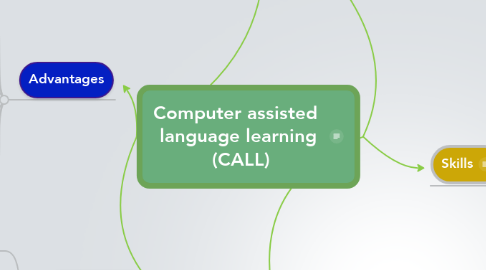Computer assisted language learning (CALL)
by p RIVATE

1. Advantages
1.1. Free (cheap)
1.2. Easy to use
1.3. Entertaining
1.4. Competetive
1.5. Avalibility
1.5.1. Anytime
1.5.2. Anywhere
1.6. Adaptive learning tech
1.6.1. choice in themes
1.7. Learner autonomy
2. Disadvantages
2.1. Lack of live contact
2.2. Selforganization
2.3. Computers can't
2.3.1. judge unexpected input
2.3.2. individualise feedback beyond a predetermined list
3. Examples (online platforms for CALL)
3.1. Duolingo
3.2. Memrise
3.3. Babbel
4. Principles of Using and Designing CALL Programs
4.1. Student/learner-centeredness
4.2. Meaningful purpose
4.3. Comprehensive input
4.4. Sufficient level of stimulation
4.5. Multiple modalities
4.6. High level of interaction
5. Types of CALL Activities
5.1. Multiple-choice & true/false quizzes
5.2. Gap-filling exercise/cloze
5.3. Re-ordering/sequencing
5.4. Matching
5.5. Crossword puzzles
6. Skills
6.1. Vocabulary
6.2. Grammar
6.3. Reading
6.4. Writing
6.5. Pronunciation
6.6. Text Reconstruction


